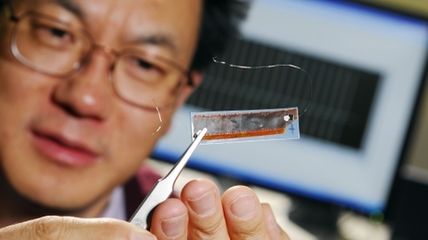美国佐治亚理工大学的科学家近日宣布,他们成功研制出一种利用人体动能驱动发电的芯片,能够将人体在活动时产生的能量转换为电能,为随身电子设备提供电源支持。据研究人员介绍,这种芯片是由上百万根比头发丝还细500倍的线缆构成的,这些线缆能够捕捉人体的任何活动,比如行走、甚至心跳,所产生的能量,同时还能收集风、轮胎转动及其他自然界活动产生的能量,并将其转换为电能。研究人员表示,虽然目前研制的芯片发电量只有几伏,但是随着版本的不断改进,这种芯片的发电量完全足够给iPod、手机等随身电器提供电能。

 |
|
Anything from walking to a standing heartbeat could produce energy that is captured and used by nanogenerators, according to a team of scientists from Georgia Institute of Technology. |
Could your body replace mobile-device batteries? Researchers have developed a way to create the power equivalent of two double-A batteries, using nothing more than motion of the human body.
Anything from walking to a standing heartbeat could produce energy that is captured and used by nanogenerators, according to a team of scientists from Georgia Institute of Technology. This research, presented at a meeting of the American Chemical Society, demonstrated how a small, flexible chip containing millions of tiny wires—500 times thinner than a human hair—could use the human heart to create electrical energy. The researchers used a nanogenerator to power an LED light and LCD display.
Any kind of bodily movement could theoretically be used to generate power, and nanowires can also generate electricity in response to wind, rolling tires, or other kinds of motion. The technology is not new, but these most recent findings do signal a breakthrough.
Researchers are convinced the technology has a future. “While a few volts may not seem like much, it has grown by leaps and bounds over previous versions of the nanogenerator,” said the project's lead scientist, Zhong Lin Wang. “Additional nanowires and more nanogenerators, stacked together, could produce enough energy for powering larger electronics, such as an iPod or charging a cell phone.”
相关阅读
(Agencies)

(中国日报网英语点津 Helen 编辑)